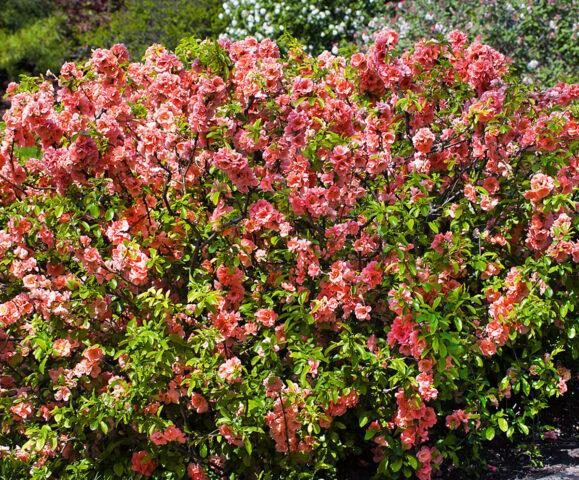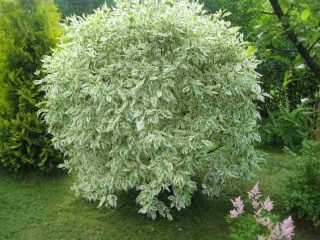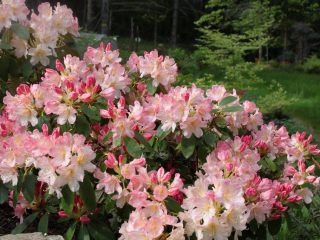Content
The magnificent Cameo quince, or Japanese chaenomeles, is a beautiful perennial shrub. It is used in landscape design and folk medicine. The fruits are edible and suitable for preservation. The plant is undemanding to growing conditions, unpretentious in care, and resistant to a number of negative factors.
History of selection
Cameo is one of the varieties of Chaenomeles splendid, also called excellent. The hybrid was obtained by crossing two types of quince - Japanese and beautiful.
The plant is native to East Asia. It was grown for decorative purposes and for use in folk medicine.
Description of the magnificent Cameo quince variety
The magnificent Cameo quince belongs to the genus Chaenomeles from the Rosaceae family. It is a slow-growing deciduous shrub.
Main characteristics:
- the height of adult plants reaches 1-1.5 m;
- dense foliage;
- the crown is rounded, widely branched;
- branches are close-knit, prickly, thorns are rare;
- leaves are oval, slightly wavy in shape, rich green in color, with a glossy sheen;
- the crown in diameter corresponds to the height of the bush;
- a large number of double flowers, collected 2-6 pieces in corymbs;
- the color of the buds is salmon-peach, there is a pinkish tint;
- flower diameter 3-5 cm;
- central stamens yellow;
- the fruits are golden-yellow in color, round or ovoid in shape, up to 5 cm in diameter, in appearance they resemble small apples;
- the plant is bisexual;
- life expectancy up to 16 years.
Quince magnificent Cameo is a good honey plant. During flowering, the bush attracts butterflies. The buds appear on last year's shoots, so heavy pruning is not recommended.
The fresh fruits of the plant are tasteless, but smell pleasant. Due to their healing properties, they have found use in folk medicine. Fruits normalize metabolism, acid-base balance, and increase immunity. They are useful to use for muscle and nervous pathologies, anemia, and exhaustion.
In addition to the fruits of the magnificent Cameo quince, its leaves have beneficial properties. A decoction of them can cure seborrhea and reduce hair fragility. Leaf extract relieves inflammation, softens and moisturizes the skin.
The photo of Cameo quince in full bloom clearly shows the high decorativeness of the shrub and the abundance of large blooming buds.

Quince Cameo is resistant to adverse factors and grows well in urban environments
Characteristics
Quince magnificent Cameo is a bisexual plant. For a good harvest, it is recommended to plant next to two representatives of other varieties.
Drought resistance, winter hardiness
Quince magnificent Cameo belongs to the fourth frost resistance zone. The shrub can withstand cold temperatures down to -34 °C.It can be grown in Moscow and the Moscow region, and most other Russian regions. The shrub has high drought resistance. It tolerates high humidity well, if there is no stagnation of water in the soil, high-quality drainage is organized.
Flowering period, ripening time and yield
The magnificent Cameo quince blooms in late spring or early summer and lasts about 3-4 weeks. By this time, the leaves have not yet had time to fully bloom. Late flowers may appear in the fall. At the same time, fruiting begins. Ripening ends by the end of September or October.
At first, the color of the fruit is greenish-yellow. It becomes golden after ripening, and a slight blush is possible. The Kameo quince fruits taste bitter, so they are not consumed fresh. The harvested crop can be used to make jelly, jam, compotes, marshmallows, and marmalade.
The magnificent Cameo quince bears fruit regularly. The harvest is stored for a long time and can last until spring. The fruits can be prepared as dried fruits and used for making compotes.
The yield of Cameo quince is not bad. The bush can bear 2-5 kg of fruit. They begin to appear 5-6 years after planting.
Resistance to diseases and pests
Quince magnificent Cameo has good immunity. The plant is resistant to pests and various fungi.
Advantages and disadvantages of the variety
Quince magnificent Cameo attracts gardeners mainly for its high decorative value. Edible fruits are a nice addition.

Cameo quince buds do not bloom at the same time, so flowering lasts up to a month
Pros:
- highly decorative;
- self-fertility;
- abundant flowering;
- resistance to frost, drought;
- unpretentiousness to growing conditions;
- low maintenance requirements;
- regular fruiting;
- good immunity to fungal diseases;
- resistance to pests.
The variety has no downsides.
Features of planting and care
Japanese quince Cameo is undemanding and therefore easy to grow. The shrub will respond to the right place for planting and proper care with abundant flowering and a good harvest.
Landing dates
You can plant the magnificent Cameo quince from July to October. Before this, it is recommended to store seedlings at 0-2 °C. Another option is spring planting. The soil should warm up to 8-10 °C.
Planting dates should be based on the climate in the region. It is better to carry out the work several weeks before the cold snap. This will give the seedlings time to establish themselves so they can survive the winter.
Landing site requirements
Quince magnificent Cameo prefers sunny areas, although it tolerates light shading. Protection from the north wind is required. The shrub grows well in light and acidic soils saturated with humus.
Landing algorithm
The site for Cameo quince needs to be prepared in advance, preferably in the fall. You need to dig up the ground, remove weeds and plant debris.
Landing algorithm:
- Prepare a hole with a side of 0.5 m, depth up to 0.8 m.
- Add 1.5 buckets of humus, 0.5 kg of ash, 0.3 kg of superphosphate and 30 g of potassium nitrate to the excavated soil.
- Pour a heap of the resulting soil mixture into the hole.
- Place the seedling in the hole. The root collar should be flush with the surface.
- Fill the hole with soil and compact it.
- Water generously.
- Shorten the shoots, leaving 0.2 m.
Quince does not tolerate transplantation well, so it is important to immediately place it in a permanent place. This feature is associated with a long tap root, which is easy to damage.

Seedlings should be spaced at intervals of 1 m - dense planting increases the risk of disease
Aftercare
Thanks to the resistance of the magnificent Cameo quince to cold, drought and high humidity, it is easy to care for. Main stages:
- Water young plants regularly, last time in August. Over-watering has a bad effect on the taste of the fruit. Watering every month is sufficient.
- Feeding 2-3 times a year. In spring, nitrogen compounds, in summer and autumn, a combination of potassium and phosphorus in liquid form.
- Annual pruning. Carry out after flowering. Remove crooked, old, diseased shoots, thin out the crown.
- Regular loosening and weeding.
- Mulching the tree trunk circle. You can use tree bark, sawdust, peat. A layer of 5 cm is sufficient.
When applying fertilizers to the planting hole, fertilizing is not needed for the first year. If the number of fruits is not important, you can do without fertilizing in the future.
If the climate in the region is warm, you can form a tree with 3-6 trunks. He will have a common crown. Formative pruning is carried out no earlier than five years. For good flowering and fruiting, it is recommended to leave 10-15 branches of different ages.
Cameo quince does not require special insulation if it is covered with snow in winter. Otherwise there is a risk of frostbite. For insulation, you can use spruce branches and shield shelter. Young seedlings should be protected with agrofibre, a cardboard box or a box.
Quince Cameo has good immunity to fungal diseases, but they can be provoked by stagnant moisture and heavy rainfall. Preventive treatments will help prevent infection. Bordeaux mixture, Horus and Abiga Peak are effective.
Acaricides should be used to prevent pests. Before the buds open, you can apply Aktara, Actellik, Karbofos.
Application in landscape design
Quince magnificent Cameo looks good in both single and group plantings. It can be used to create edges, low but dense hedges. It will perform a protective and decorative function.

The Cameo quince hedge turns out to be asymmetrical, but the beautiful flowering many times compensates for this disadvantage
When planted alone, Cameo quince will look good on a lawn or lawn. It can be placed in a patio or small garden. The variety is excellent for creating decorative compositions. It can be combined with perennial flowers and other shrubs:
- barberry;
- hawthorn;
- weigela;
- heather;
- honeysuckle;
- Mahonia;
- golden currant (golden);
- spirea;
- forsythia.

Even a faded Cameo quince will be beautiful thanks to the abundance and brightness of its greenery
Japanese quince is an excellent option for creating an oriental-style garden. The shrub looks good on rocky slopes and alpine hills.
Conclusion
Magnificent quince Cameo attracts with its high decorative value, healing properties and the possibility of processing the fruit - canning, preparing delicacies. The shrub does not require care, but does not tolerate transplantation. The plant looks good in group planting and alone.
https://youtu.be/NaadVWEJmWs








